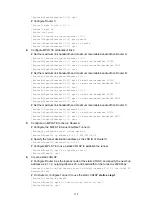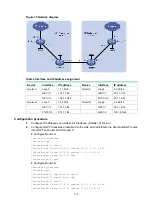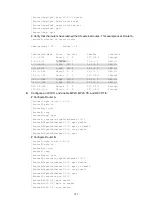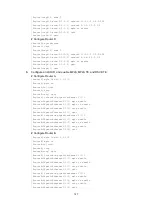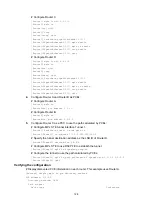
118
Admin State : Normal
Ingress LSR ID : 1.1.1.9 Egress LSR ID : 4.4.4.9
Signaling : RSVP-TE Static CRLSP Name : -
Resv Style : SE
Tunnel mode : -
Reverse-LSP name : -
Reverse-LSP LSR ID : - Reverse-LSP Tunnel ID: -
Class Type : CT0 Tunnel Bandwidth : 2000 kbps
Reserved Bandwidth : 2000 kbps
Setup Priority : 7 Holding Priority : 7
Affinity Attr/Mask : 0/0
Explicit Path : -
Backup Explicit Path : -
Metric Type : TE
Record Route : Disabled Record Label : Disabled
FRR Flag : Disabled Bandwidth Protection : Disabled
Backup Bandwidth Flag: Disabled Backup Bandwidth Type: -
Backup Bandwidth : -
Bypass Tunnel : No Auto Created : No
Route Pinning : Disabled
Retry Limit : 10 Retry Interval : 2 sec
Reoptimization : Disabled Reoptimization Freq : -
Backup Type : None Backup LSP ID : -
Auto Bandwidth : Disabled Auto Bandwidth Freq : -
Min Bandwidth : - Max Bandwidth : -
Collected Bandwidth : -
# Execute the
display ip routing-table
command on Router A. The output shows a static route entry
with interface Tunnel 1 as the output interface. (Details not shown.)
Establishing an inter-AS MPLS TE tunnel with RSVP-TE
Network requirements
Router A and Router B are in AS 100. Router C and Router D are in AS 200. AS 100 and AS 200 use
OSPF as the IGP.
Establish an EBGP connection between ASBRs Router B and Router C. Redistribute BGP routes
into OSPF and OSPF routes into BGP, so that AS 100 and AS 200 can reach each other.
Use RSVP-TE to establish an MPLS TE tunnel from Router A to Router D to transmit data between
the two IP networks. The tunnel requires a bandwidth of 2000 kbps. The maximum bandwidth of the
link that the tunnel traverses is 10000 kbps, and the maximum reservable bandwidth of the link is
5000 kbps.







